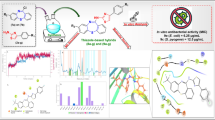Abstract
Natural product-inspired libraries of molecules with diverse architectures have evolved as one of the most useful tools for discovering lead molecules for drug discovery. In comparison to conventional combinatorial libraries, these molecules have been inferred to perform better in phenotypic screening against complicated targets. Diversity-oriented synthesis (DOS) is a forward directional strategy to access such multifaceted library of molecules. From a successful DOS campaign of a natural product-inspired library, recently a small molecule with spiroindoline motif was identified as a potent anti-breast cancer compound. Herein we report the subcellular studies performed for this molecule on breast cancer cells. Our investigation revealed that it repositions microtubule cytoskeleton and displaces AKAP9 located at the microtubule organization centre. DNA ladder assay and cell cycle experiments further established the molecule as an apoptotic agent. This work further substantiated the amalgamation of DOS-phenotypic screening-sub-cellular studies as a consolidated blueprint for the discovery of potential pharmaceutical drug candidates.






Similar content being viewed by others
Abbreviations
- AKAP9:
-
A-kinase-anchoring protein 9
- DOS:
-
Diversity-oriented synthesis
- MTOC:
-
Microtubule-organizing centre
References
Coughlin SS, Ekwueme DU (2009) Breast cancer as a global health concern. Cancer Epidemiol 33(5):315–318. doi:10.1016/j.canep.2009.10.003
Guan X (2015) Cancer metastases: challenges and opportunities. Acta Pharm Sin B 5(5):402–418. doi:10.1016/j.apsb.2015.07.005
Mallick N, Kausar MA, Chattopadhyay S, Ahad A, Zaidi S, Husain SA, Siddiqui WA (2012) Mutational analysis of prohibition—a highly conserved gene in Indian female breast cancer cases. Asian Pac J Cancer Prev 13(10):5113–5117
Masters GA, Krilov L, Bailey HH, Brose MS, Burstein H, Diller LR, Dizon DS, Fine HA, Kalemkerian GP, Moasser M, Neuss MN, O’Day SJ, Odenike O, Ryan CJ, Schilsky RL, Schwartz GK, Venook AP, Wong SL (2015) Patel clinical cancer advances 2015: annual report on progress against cancer from the American Society of Clinical Oncology. J Clin Oncol 33(7):786–809. doi:10.1200/JCO.2014.59.9746
Adams DL, Martin SS, Alpaugh RK, Charpentier M, Tsai S, Bergan RC, Ogden IM, Catalona W, Chumsri S, Tang C-M (2014) Circulating giant macrophages as a potential biomarker of solid tumors. Proc Natl Acad Sci USA 111(9):3514–3519. doi:10.1073/pnas.1320198111
Burke MD, Schreiber SL (2004) A planning strategy for diversity-oriented synthesis. Angew Chem Int Ed Engl 43(1):46–58
Ibbeson BM, Laraia L, Alza E, O’Connor CJ, Tan YS, Davies HML, McKenzie G, Venkitaraman AR, Spring DR (2014) Diversity-oriented synthesis as a tool for identifying new modulators of mitosis. Nat Commun 5:3155. doi:10.1038/ncomms4155
Sanivarapu S, Thulluri C, Iyer PS, Tangirala RS, Gundla R, Addepally U, Murthy YL, Velide L, Sen S (2013) Synthesis of privileged scaffolds by using diversity-oriented synthesis. Chem Asian J 8:1168–1176
Sehrawat S, Ernandez T, Cullere X, Takahashi M, Ono Y, Komarova Y, Mayadas TN (2011) AKAP9 regulation of microtubule dynamics promotes Epac1-induced endothelial barrier properties. Blood 117(2):708–718. doi:10.1182/blood-2010-02-268870
Pihan GA (2013) Centrosome dysfunction contributes to chromosome instability, chromoanagenesis, and genome reprograming in cancer. Front Oncol 3:277. doi:10.3389/fonc.2013.00277
Franken NAP, Rodermond HM, Stap J, Haveman J, van Bree C (2006) Clonogenic assay of cells in vitro. Protocol. doi:10.1038/nprot.2006.339
Fadok VA, Bratton DL, Guthrie L, Henson PM (2001) Differential effects of apoptotic versus lysed cells on macrophage production of cytokines: role of proteases. J Immunol 166(11):6847–6854
Koopman G, Reutelingsperger CP, Kuijten GA, Keehnen RM, Pals ST, van Oers MH (1994) Annexin V for flow cytometric detection of phosphatidylserine expression on B cells undergoing apoptosis. Blood 84:1415–1420
Ridley AJ, Schwartz MA, Burridge K, Firtel RA, Ginsberg MH, Borisy G, Parsons JT, Horwitz AR (2003) Cell migration: integrating signals from front to back. Science 302:1704–1709
Kurosaka S et al. (2010) Arginylation-dependent neural crest cell migration is essential for mouse development. PLoS Genet 6(3):e1000878. doi:10.1371/journal.pgen.1000878
Paulucci-Holthauzen AA, Vergara LA, Bellot LJ, Canton D, Scott JD, O’Connor KL (2009) Spatial distribution of protein kinase A activity during cell migration is mediated by A-kinase anchoring protein AKAP Lbc. J Biol Chem 284(9):5956–5967. doi:10.1074/jbc.M805606200
Tröger J (2012) A-kinase anchoring proteins as potential drug targets. Br J Pharmacol 166(2):420–433. doi:10.1111/j.1476-5381.2011.01796.x
Elmore S (2007) Apoptosis: a review of programmed cell death. Toxicol Pathol 35(4):495–516
Nagata S (2000) Apoptotic DNA fragmentation. Exp Cell Res 256:12–18
Quail DF, Joyce JA (2013) Microenvironmental regulation of tumor progression and metastasis. Nat Med 19(11):1423–1437. doi:10.1038/nm.3394
Han X, Xu B, Beevers CS, Odaka Y, Chen L, Liu L, Luo Y, Zhou H, Chen W, Shen T, Huang S (2012) Curcumin inhibits protein phosphatases 2 A and 5, leading to activation of mitogen-activated protein kinases and death in tumor cells. Carcinogenesis 33(4):868–875. doi:10.1093/carcin/bgs029
Xu B, Lee KK, Zhang L, Gerton JL (2013) Stimulation of mTORC1 with l-leucine rescues defects associated with roberts syndrome. PLoS Genet 9(10):e1003857. doi:10.1371/journal.pgen.1003857
Odaka Y, Xu B, Luo Y, Shen T, Shang C, Wu Y, Zhou H, Huang S (2014) Dihydroartemisinin inhibits the mammalian target of rapamycin-mediated signaling pathways in tumor cells. Carcinogenesis 35(1):192–200. doi:10.1093/carcin/bgt277
Xu B, Gogol M, Gaudenz K, Gerton JL (2016) Improved transcription and translation with l-leucine stimulation of mTORC1 in roberts syndrome. BMC Genomics 17:25. doi:10.1186/s12864-015-2354-y
Acknowledgements
Shailja Singh and Subhabrata Sen thank the Department of Biotechnology, Govt. of India, for the pilot grant BT/Med/Pilot Project Cancer/2014. Seema Sehrawat is the recipient of Bio-CARe Award from the Ministry of Science and Technology, Department of Biotechnology, Govt. of India, and acknowledges the funding support. NK and SH are supported by fellowship from Shiv Nadar University. Shailja Singh acknowledges the funding provided by IYBA, Dept. of Biotechnology, Govt. of India. We also sincerely thank financial support received from LRE JNU and ICMR CAR 2016 -17.
Author information
Authors and Affiliations
Corresponding authors
Additional information
Naveen Kumar and Santanu Hati have contributed equally to this work.
Rights and permissions
About this article
Cite this article
Kumar, N., Hati, S., Munshi, P. et al. A novel spiroindoline targets cell cycle and migration via modulation of microtubule cytoskeleton. Mol Cell Biochem 429, 11–21 (2017). https://doi.org/10.1007/s11010-016-2932-6
Received:
Accepted:
Published:
Issue Date:
DOI: https://doi.org/10.1007/s11010-016-2932-6




